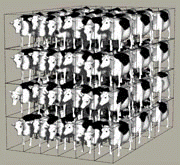Animal Science, Department of

World Congress on Genetics Applied to Livestock Production: 3rd (1986)
Date of this Version
1986
Abstract
In most European."dual purpose breeds beef merit is paid attention to by selection among performance tested bulls where comparatively much weight is given to growth rate of performance pasted bulls and relatively little weight to muscling and thus to carcass meat content. The genetic correlation between beef and dairy merit appears to be negative. This, in combination with large ad effective selection pressure on milk leads to negating the effects of the little and relatively inaccurate selection for beef merit at the best. Field progeny testing for beef merit can be economical and will permit to neutralize or even improve the beef merit of dual purpose cattle without much reduction in genetic progress of dairy merit.
In dual purpose cattle breeds milk and meat are of roughly equal importance, i.e. the minor trait should not contribute less than some 20 - 25 % to the total income. The selection objectives for dairy traits are clearly defined and there exists a close correspondence with selection criteria such as lactation or part lactation yield.
The selection objective in case of beef production is the quantity of lean meat or the efficiency of lean meat production. However, the selection criteria are numerous and they need to be included in fairly complex prediction equations. Frequently their commercial relevance is not obvious. Also, prospective feeder animals are usually marketed very early - frequently at an age of one week - where the fattening quality can be poorly appraised and no or little price differentiation is practized.


Comments
Published in 3rd World Congress on Genetics Applied to Livestock Production, edited by Gordon E. Dickerson and Rodger K. Johnson, 4 vols. (Lincoln: University of Nebraska Institute of Agriculture and Natural Resources, 1986). Copyright © 1986 Board of Regents University of Nebraska.